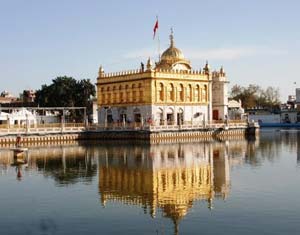Golden Temple

“Amritsar is one of Punjab’s principal cities, dating back in history over 400 years. It is known more for the world famous Golden Temple, the seat of Sikh religion.”
Situated on the north-western border of India, the city is also gateway for the travelers on the overland route through Pakistan. The Wagah border, which is the check-post is about 29 kms away. Amritsar literally means “the pool of nectar”, the name derived from a pool constructed at the sacred site in the 16th century.
Shahid Ganj Sahib

GURUDWARA SHRI BABA DEEP SINGH JI SHAHEED is situated in the prikarma of GURUDWARA SHRI HARIMANDIR SAHIB AMRITSAR. BABA DEEP SINGH JI was the leader of the famous ” Shaheedan Di Missel ” among the 12 missels. Apart from getting the GURU GRANTH SAHIB’S saroop written, he also actively participated in all the major battles that took place in the 18th century. In the year 1757 when BABA DEEP SINGH JI got the news that Taimurshah & Jahan Khan have shown disrespect for SHRI DARBAR SAHIB and also started filling the holy sarovar, even though BABA JI was in old age he carried a 18 ser heavy Khanda in his hand to free SHRI DARBAR SAHIB.
Goindwal Sahib

Goindwal Sahib, is located in Taran Taran district in the state of Punjab in India about 23 km from Tarn Taran Sahib. In the 16th century it became an important center for the Sikh religion during the Guruship of the Guru Amar Das. Goindwal is on the banks of the river Beas and is one of the focal points of small scale industries of Tarn Taran district.
Guru Amar Das (the third Guru or the third Nanak) stayed in Goindwal for 33 years where he established a new centre for preaching Sikhism. A Baoli (stepwell), paved with 84 steps was constructed there. Some devout believe that by reciting Japji Sahib, the divine Word revealed to Guru Nanak Dev at each of the 84 steps after taking a bath in the Baoli provides Moksha, liberation from 84,00,000 cycles of life of this world and unity with God (mukhti). Goindval is where Guru Amar Das met Guru Ram Das, the next Guru. Guru Arjan Dev was also born there on 15 April 1563. It is called axis of Sikhism as it was the first center of Sikhism.
Jallianwala Bagh

“The 1919 Amritsar massacre, known alternatively as the Jallianwala Bagh massacre after the Jallianwala Bagh (Garden) in the northern Indian city of Amritsar, was ordered by General R.E.H. Dyer.”
On Sunday April 13, 1919, which happened to be ‘Baisakhi’, one of Punjab’s largest religious festivals, fifty British Indian Army soldiers, commanded by Brigadier-General Reginald Dyer, began shooting at an unarmed gathering of men, women, and children without warning.
Ram Tirath

Located 11 Km West of Amritsar on Chogawan road, dates back to the period of Ramayana, Rishi Valmiki’s hermitage. The place has an ancient tank and many temples. A hut marks the site where Mata Sita gave birth to Luv & Kush and also, still extant are Rishi Valmiki’s hut and the well with stairs where Mata Sita used to take her bath. The Bedis of Punjab (Guru Nanak Dev , the founder Prophet of Sikhism was a Bedi) trace their descent from Kush and Sodhis (the 10th Prophet of Sikhism, Guru Gibind Singh was a Sodhi) from Luv. A four day fair, since times immemorial is held here starting on the full moon night in November. 16 Kilometres west on Choganwan road is Ram Tirath, commemorating Maharishi Balmik Ji´s heritage.
Durgiana Temple (Lakshmi Narain Temple)

Built in the third decade of the 20th Century it echoes, not the traditional Hindu temple architecture, but that of the Golden Temple and, in a similar manner rises from the midst of a tank and has canopies and the central dome in the style of the Sikh temple. One of the greatest reformers and political leaders of resurgent India, Pandit Madan Mohan Malviya, laid its foundation stone. It is a well-known repository of Hindu scriptures.
Wagha Border

“Wagah (or Wagha) is a border town straddling the line between Pakistan and India, 27 km from Amritsar(India). This is the only crossing point between Pakistan and India that is regularly open to foreigners.”
There is daily flag raising and lowering ceremony at Wagah Border, done with fascinating pomp and ceremony that involves lots of tall soldiers in massive turbans goose-stepping about and slamming gates. Both the Indian and Pakistani border forces do this and it has become a tradition for people from both sides gather and see this. Both sides synchronize their parade and the entire event is meant to create a feel-good/patriotic fervour amongst the crowd. It is called the beating retreat ceremony.
Maharaja Ranjit Singh Panoroma

Maharaja Ranjit Singh’s reign was also known for all round development, secular values and patriotic fervour. Keeping all these aspects in mind, the Amritsar has come up with many such things that reminds one of Maharaja Ranjit Singh’s rule.
The National Council of Science Museums in cooperation with the State government has recently set up Maharaja Ranjit Singh panorama, which is only second of its kind in the country. Spread on a sprawling 4.5 acres of land in the historic Rambagh heritage Garden, the panorama with its long, cylindrical architecture, is an all-captivating marvel for visitors.
